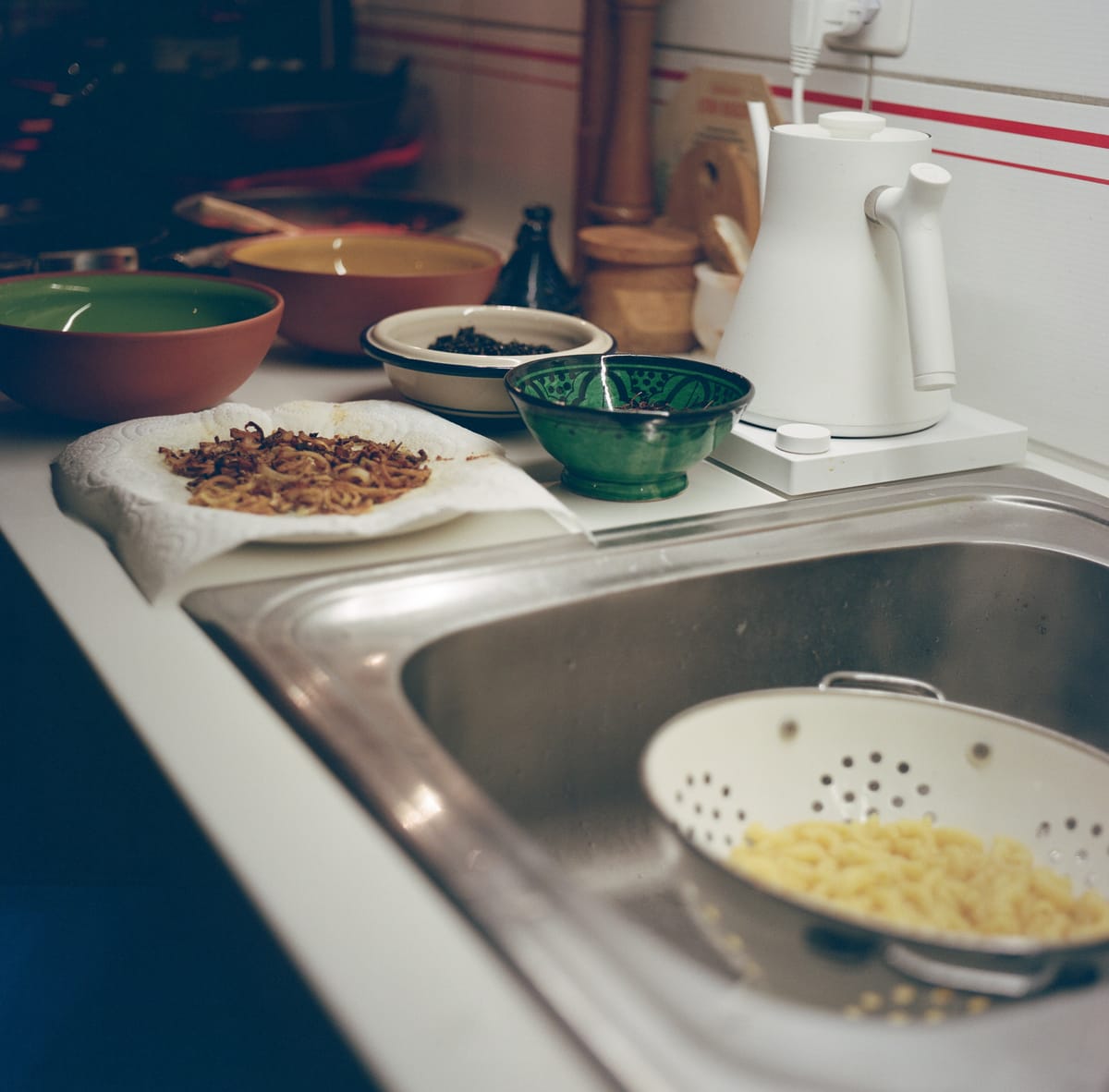What to eat EGYPT 🇪🇬 Koshari
Koshari itself has become synonymous with Egyptian cuisine. The recipe below is based on the dish as prepared by an Egyptian friend’s grandmother...

Koshari
Published May 2, 2025 · by Amanda Rivkin Häsler
Koshari is one of these national dishes with not so deep nor historic roots despite belonging to an ancient civilization. It is really only in the last century or even half century that it has taken hold of the Egyptian people to the extent that it can be considered the country’s national dish.
A vegetarian, or even vegan dish if only vegetable oil is used, consisting of pasta, tomato sauce, lentils, rice, onions and chickpeas with spices such as cumin, curry, or a blend known as baharat depending on who is making koshari, and where, arrived only in the nineteenth or early twentieth century. History conflicts as to when exactly, but koshari’s origin story universally credits the British soldiers who arrived during the country’s colonial period along with Indians from other parts of their empire.
Now sold on every street corner, most restaurants and many homes, koshari is a name derived from the Hindi khichri or khichdi designating a rice and lentil dish. Cheap and filling, it first gained traction among workers and laborers before its popularity proved infectious and a taste for it spread to the rest of society.
The British explorer Sir Richard Burton wrote of koshari as a breakfast dish among the people living along the Suez as early as 1853 in his book Journey to Egypt and the Hijaz. But noted contemporary Egyptian Jewish food writer Claudia Roden, who left Egypt in the 1950s, has no memory of the dish from her childhood in Cairo.
“I had never eaten of known of koshary in Egypt before 1952, when I arrived in Paris,” Roden told American radio network National Public Radio (NPR) in 2017. “No one ever mentioned the recipe when I was researching my first book almost sixty years ago,” she said then, later adding, “Of course, it might have been sold in some quarter of Cairo that I never went to.”
From Burton’s time in Egypt to Roden’s childhood, we arrive on what is now known as Cairo’s most famous and among its oldest koshari restaurants, Abou Tarek Koshary. Located at the corner of Maarouf and Champollion streets in the heart of downtown Cairo’s car mechanics’ district, it is owned by Yousef Zaki, also or perhaps better known as Abou Tarek. He has become one of the iconic figures of Egyptian culinary life since the days when he first started selling koshari at age 13 after his father died to provide for his family.
Initially just a food cart, Zaki’s efforts grew into a restaurant due to police harassment, a grievance with a clear echo in present times as allegedly the force that kicked off the Arab Spring in 2011 when a Tunisian vegetable seller set himself alight in Sidi Bouzid protesting such treatment. While the Middle East may have been remade in the aftermath and a myth of pan-Arab uprisings growing from there, so too with Abou Tarek’s central Cairo koshari restaurant which now boasts numerous locations.
While the British-Indian colonial legacy of koshari is certain, many sources point to the small Italian community of Cairo as contributing the maacarona, as macaroni is known in Egyptian Arabic. However, as Swiss Global Dining covered in our look at Italian pasta and Claudia Roden reiterates, “Pasta is an Arab thing mentioned in medieval culinary manuscripts.” It is not in fact, as many wrongly believe the result of Marco Polo’s travels in China – a legend that was born from the misadventure of American marketing materials more than anything.
Now synonymous with Egypt across social class and geographical boundaries, regional varieties proliferate, such as an Alexandria variety that includes yellow lentils and makes use of curry and cumin in the rice to give the dish a uniform color. Koshari itself has become synonymous with Egyptian cuisine.
The recipe below is based on the dish as prepared by an Egyptian friend’s grandmother, the same one who taught her the most perfect English, a sure indication that the dish has reached into the echelons of the capital’s well-educated and utterly international elite.

Recipe
Ingredients:
2 small onions or one big onion
Chickpea flour (or white flour)
Olive oil
½ cup short angel hair noodles
1 cup pre-cooked or sous vide black lentils
7 cloves of garlic
½ cup of chickpeas
350 grams of tomato sauce
2 tablespoons cumin
Salt
Pepper
200 grams of elbow macaroni
3 tablespoons white wine vinegar
2 tablespoons of red pepper
¼ cup of water
Step 1: Slice the onion in half and peel. Cut in half ring fashion and coat with chick pea flour (or white flour) and let sit for ten minutes. After ten minutes, fry in olive oil until golden brown. Pull from heat and let cool on a paper towel to absorb excess oil and keep crunchiness and set aside. Pull from heat when done.
Step 2: Return oil to heat and add half a cup of angel hair noodles. Fry until brown and remove from heat and remove noodles from pan and set aside.
Step 3: Return oil to heat and fry one cup of black lentils and remove from heat, removing lentils from pan and set aside.
Step 4: Now it is time to turn towards our sauces. Chop seven cloves, setting three aside. In oil, lightly fry four cloves. Add chick peas to toast them and then the tomato sauce. Turn down to a low heat and add cumin, salt and pepper to taste.
Step 5: Boil the elbow macaroni in water until tender.
Step 6: As the water is boiling, prepare the da’aa, a sauce that will first coat the elbow macaroni. Toast garlic and add white wine vinegar and red pepper. Add water and bring to a boil.
Step 7: Pull the macaroni from heat and drain. Place in serving dishes and then begin the assembly. First add the da’aa sauce, Then the black lentils. On top of the lentils add tomato sauce, the fried crispy short angel hair noodles and top with fried onions. On the side, you can offer an African-style spicy pepper sauce with ginger for those who enjoy extra spice.
Tips, tricks and notes:
The nice thing about koshari is almost every ingredient is already likely in your pantry. It is also a relatively easy, uncomplicated and affordable way to feed a great many people.
However, for wonderful sous vide black lentils, check the produce section of Coop as they have this available.
For the spicy pepper sauce with ginger, this is available at Tropical Zone, an African grocery store where we tend to find most of our harder to find ingredients from the continent, located at Herzogstrasse 16 in Bern.
Learn where to eat Egyptian food in Switzerland.
Follow our social media pages @swissglobaldining on Instagram, TikTok and YouTube